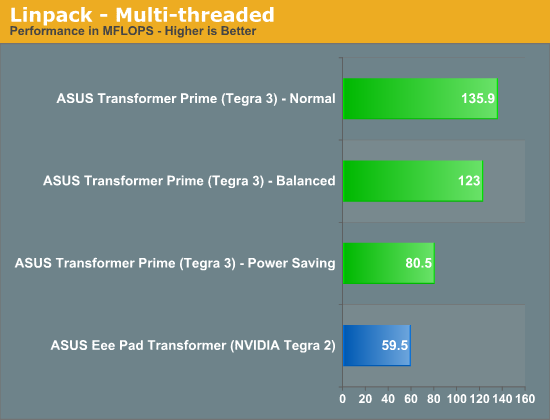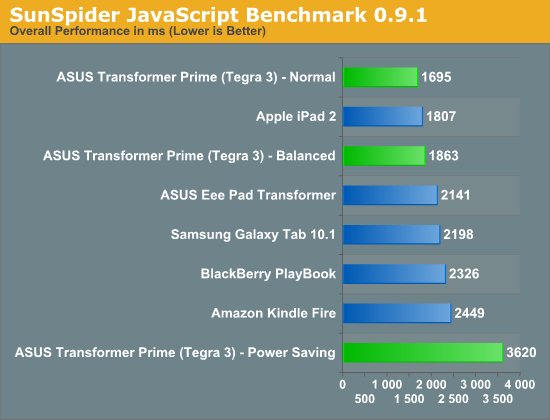ASUS Eee Pad Transformer Prime & NVIDIA Tegra 3 Review
by Anand Lal Shimpi on December 1, 2011 1:00 AM ESTCPU Performance
The big news with Tegra 3 is that you get four ARM Cortex A9 cores with NEON support instead of just two (sans NEON) in the case of the Tegra 2 or most other smartphone class SoCs. In the short period of time I had to test the tablet I couldn't draw many definitive conclusions but I did come away with some observations.
Linpack showed us healthy gains over Tegra 2 thanks to full NEON support in Tegra 3:


As expected, finding applications and usage models to task all four cores is pretty difficult. That being said, it's not hard to use the tablet in such a way that you do stress more than two cores. You won't see 100% CPU utilization across all four cores, but there will be a tangible benefit to having more than two. Whether or not the benefit is worth the cost in die area is irrelevant, it only means that NVIDIA (and/or its partners) have to pay more as the price of the end product to you is already pretty much capped.


The bigger benefit I saw to having four cores vs. two is that you're pretty much never CPU limited in anything you do when multitasking. Per core performance can always go up but I found myself bound either by the broken WiFi or NAND speed. In fact, the only thing that would bring the Prime to a halt was if I happened to be doing a lot of writing to NAND over USB. Keyboard and touch interrupts were a low priority at that point, something I hope to see addressed as we are finally entering the era of performance good enough to bring on some I/O crushing multitasking workloads.

Despite having many cores at its disposal, NVIDIA appears to have erred on the side of caution when it comes to power consumption. While I often saw the third and fourth cores fire up when browsing the web or just using the tablet, NVIDIA did a good job of powering them down when their help wasn't needed. Furthermore, NVIDIA also seems to prefer running more cores at lower voltage/frequency settings than fewer cores at a higher point in the v/f curve. This makes sense given the non-linear relationship between voltage and power.
From a die area perspective I'm not entirely sure having four (technically, five) A9 cores is the best way to deliver high performance, but without a new microprocessor architecture it's surely more efficient than just ratcheting up clock speed. I plan on providing a more thorough look at Tegra 3 SoC performance as I spend more time with a fixed Prime, but my initial impressions are that the CPU performance isn't really holding the platform back.










204 Comments
View All Comments
Tchamber - Thursday, December 1, 2011 - link
I'm glad you brought up the fact that the Prime has a higher resolution than the iPad2, I think a lot of people overlook that when then see performance numbers. This seems to be the tablet I wanted when I bought my 1st gen iPad, if I like it, I'm done with Appletunes. Thanks for the good review.tim851 - Thursday, December 1, 2011 - link
They were reviewed at the same resolution(s)...hakimio - Thursday, December 1, 2011 - link
CNET reviewers also got a unit with defective WIFI. So don't worry - you are not alone.Morelian - Thursday, December 1, 2011 - link
Nice review. As an original Ipad owner I am always interested in new tablets but so far nothing since the original Ipad would get me to replace my current tablet. I did get my wife an Ipad 2 and while it is speedier the function of my original product still holds up.I really don't get the back camera on these things-a tablet is too big to really use as one's camera of choice and if you have a tablet surely a phone would be preferable? The front facing cam I understand and that would let people do the facetime/skype thing which I see as potentially useful.
I take my Ipad to work with me. When I have spare time, I'll use it to check my email-much easier to read on the Ipad than my phone and the Ipad facebook app is pretty good. If things get really slow I can open a book and read. Rarely I'll watch something on Netflix but currently I don't have Netflix going because the kids grab the Ipad at home and watch cartoons instead of doing homework.
As to doing work I just don't see it. A few months ago I got a Toshiba 14 inch laptop from Best Buy for 500 bucks. My thought was if I got good use out of it I'd get a Macbook Air and toss the laptop to the kids but technical limitations at work prevent me from doing what I'd really like with the notebook. The Toshiba laptop has an Intel processor with the Intel graphics, I doubt it could game and never tried, but it tosses up web pages nicely and has a nice keyboard. I can do work on it and don't mind typing on it. To do work I need Windows compatibility and I can't see where the Asus tablet would help me there.
So, I don't really get this docking station except for a way for Asus to make a few extra bucks for people who don't know what they want to use a tablet for. To me a tablet is something lightwight you use for data consumption, and for "work" you need something that runs Windows software and is reasonably designed for data entry.
The Windows 8 tablets might be the place where things are headed but a Win8 tablet with a docking station keyboard is a notebook.
I guess we'll see where all is headed.
efficacyman - Monday, December 5, 2011 - link
The rear facing camera can be used for scanning in documents using google documents or other scanning applications. The better the quality of the camera, the better the quality of the resulting product. The best camera you have is the one you have with you all the time. If you are using your tablet as your work machine, having a camera with you that is high quality can't hurt.Stupido - Thursday, December 1, 2011 - link
I'm not following this tablet development much, but I kind a like the "tablet idea"...But so far I haven't seen any tablet with USB support. Is this notion OK or I'm missing something?
Death666Angel - Thursday, December 1, 2011 - link
If by USB support you mean USB host capabilities (as in, you can plug a USB stick in and read data off it), every modern tablet/smartphone I know can do that, except Apple iStuff.Mice, gamepads, printers etc. are a more complicated matter.
Stupido - Thursday, December 1, 2011 - link
By complicated matter I guess you refer to the driver level of the OS?Because once you have USB host, than I guess it will be up to the OS to provide the correct drivers?
I don't know how different are the kernels (and their corresponding driver architecture) between Android and Linux...
I just know that Android is a fork of the standard Linux kernel...
Death666Angel - Thursday, December 1, 2011 - link
Yup, driver implementation and program support was what I was getting at. :-)If you are interested in that sort of stuff, XDAdevelopers is always a great place for any smartphone/tablet questions of a technical nature.
Stupido - Friday, December 2, 2011 - link
Thx! I'll check that...